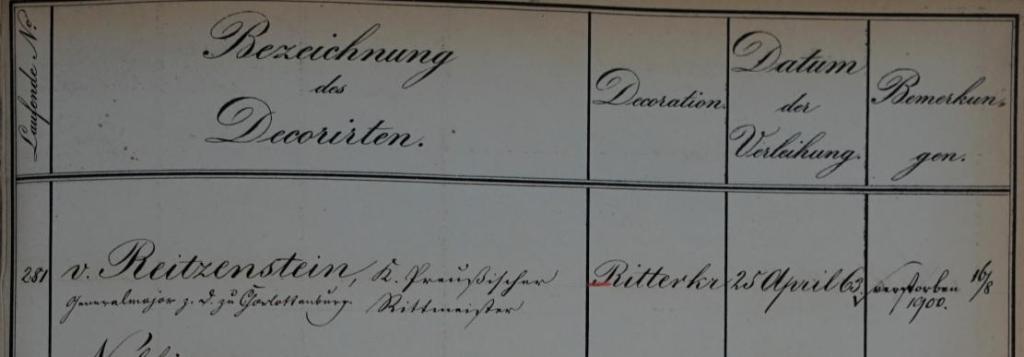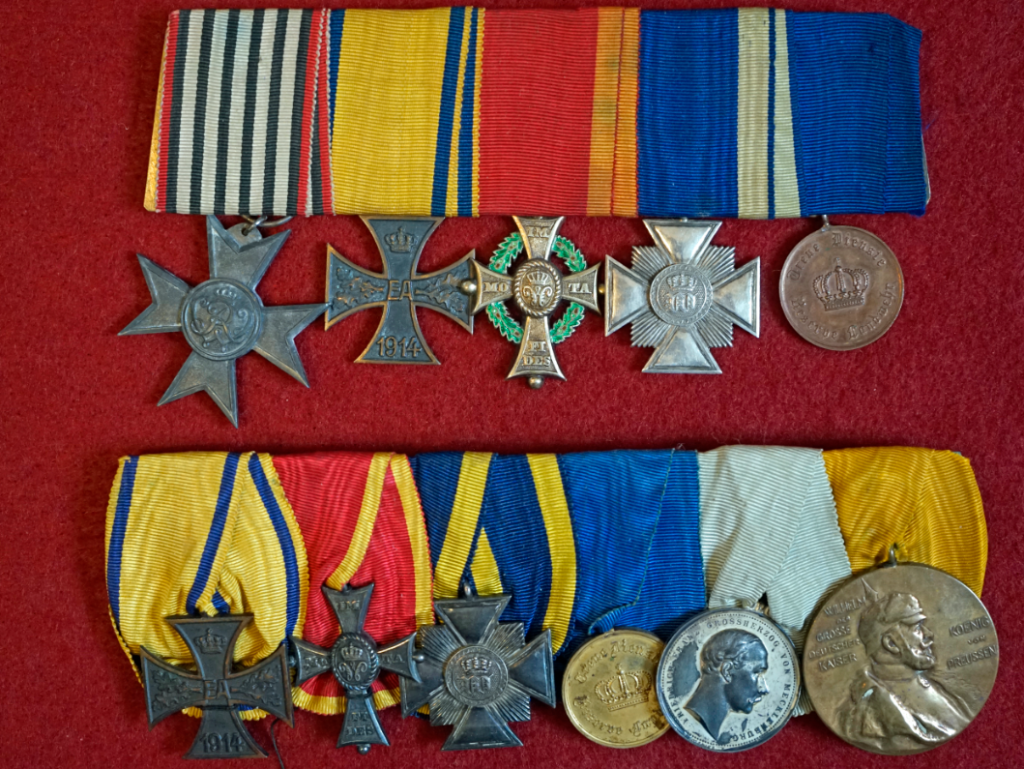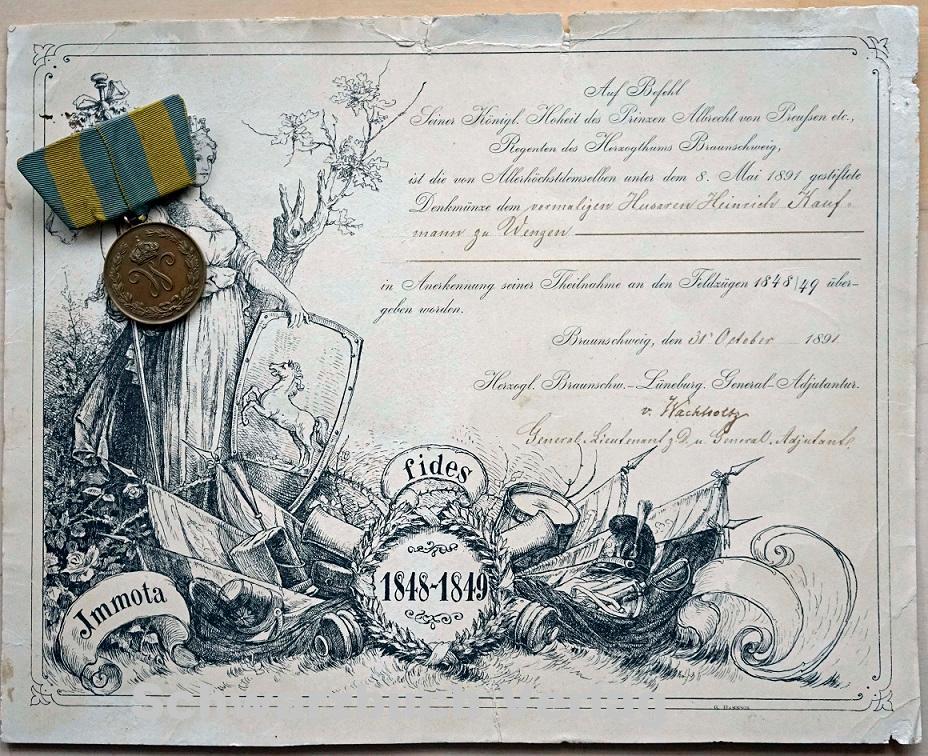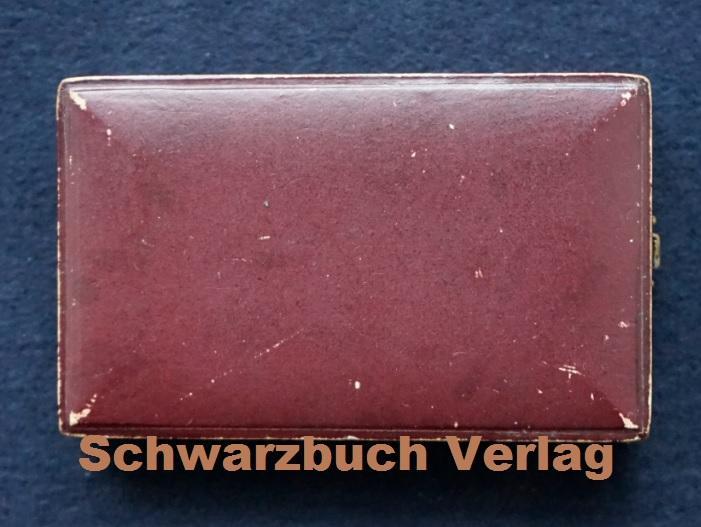-
Posts
511 -
Joined
-
Last visited
-
Days Won
10
Content Type
Profiles
Forums
Blogs
Gallery
Events
Store
Everything posted by BlackcowboyBS
-
Gentlemen, I am looking for information of long service crosses or medals for officiers and nco serving in the british army. In Germany they have been introduced starting in the 19.th century. So I wonder does something similar exists in the british army, when were they instituted, how do they look like ... and so on. I have started a first quick search in this forum, but haven't found what I was looking for. Maybe I put the wrong words in the search field above. So if there are postings regarding this topic in this forum, I would really be thankful, if you could post them here. Thank you
-
The guy that I have posted is the only von Reitzenstein that ever got an order from the duchy of Brunswick, there is no forname of him in the list. So which of your von Reitzenstein he is I don't know, but from your list it must be Egmont Heinrich Wilhelm Friedrich Abraham von Reitzenstein. This would also go along with the post from Deutschritter, but Thanks for clearing things up here!
-
Dear Gentlemen, as part of my book of the orders and medals of the Kingdom of Hannover I do need the statutes of the order of the Bath which have been valid until 1815. I am not aware if they have ever changed since the foundation of this noble order in 1725 by Georg I, so I need the statutes which have been valid in 1815. ( I just realized that they have changed and reworked in 1815, so I would need both). I would also need some high resolution photos of the order military devision of the cross and the breaststar and from the civil devision just the breast star. I own the book: The History of The Order of the Bath from James C. Risk, but haven't found the text of the statutes in it. Reason for this is, that I want to compare this order to the guelphic order which had been given to a lot of british people until 1837 when Hannover split away and wasn't ruled by the british king anymore. The resemblance between the Order of the Bath and the Guelphic order is more than obvious, so I wanted to compare statues and designs. You might send the photos and text of the statues to my emailadress. Just sent me PN here and I will give away my email address. The text of course could be also posted here. People who helped me would ofcourse be named in the acknowledgement of my book if they wanted to be named. The photos should have your copyright and this will also be named in the book. Thank you very much for your help, I am looking forward to reading from you.
-
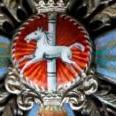
Großkreuz EK 1914 original or copy?
BlackcowboyBS replied to 03fahnen's topic in Germany: All Eras: The Iron Cross
Hi Elmar, I really appreciate your photos here. I like the artistic expression and the aesthetics of the arrangement of these photos, they are great shots. I will also try to present such photo arrangements in my next book, for me something like this makes the difference. -
I think, that we are starting to compare apples with pears now. If somebody offers a rare order on ebay and claims that he has found it in the in a hidden drawer of the desk of his grandpa that died recently and he wants to sell it. A collector is reading it and thinks to himself: man this guy really doesn't know what treasure he has and buys it because he is greedy, then I would go along with the people saying: Sorry guy your own fault, but if you can't tell a cast from a coinage then this is your own stupidity. But if a collector is buying from an auction house or an antique shop he can at least put some faith in the experience of this seller. The seller has a trade licence and is bound to sell stuff with some characteristics like originalitiy, right material, properly working, etc ... So some kind of trust should be there and therefor the seller must do all he can to fullfill this to the best of his knowledge. As we all know, that this world is not perfect and nobody else isn't either, a serious collector should do all the best he can do minimize chances of being folded by sellers, as this can allways happen. But the blame lies fully on the seller, if the buyer can proof him wrong in front of a court. In German we have the wonderfull word: Sorgfaltspflicht which could be translated into due diligance. If a seller is transgressing his due diligance then he can be put in front of a court.
-
Today I would like to present you the following two medal bars. The triple combination of service award for 21 years, merit cross of Henry the Lion and Braunschweig war merit cross at the non-combatant ribbon is found so only on order bars of Braunschweig gendarmes. (At least I don't know of any bar where this isn't the case). Decisive here is the 21 years DA, which after Brunswick joined the military convention, was awarded only to this group. Soldiers received from this time only the Prussian counterparts. So we hold that medal bars that clearly have a connection to World War I and have the Brunswick award for 21 years of service on them are 99.5% from Brunswick gendarmes. (Soldiers who received this award prior to 1886 were most likely too old to receive World War I awards as well.) The merit crosses were usually awarded to this target group after faithful and dutiful service, although the number of years of service could vary here. Oberwachtmeister usually received the 1st Class of the Cross of Merit (HdL)at some point, while Wachtmeister received only the 2nd Class. However, in 1916 not every Oberwachtmeister (senior constable) listed in the Hof- und Staatshandbuch had received a 1st class Merit Cross. The Braunschweig War Merit Cross on the noncombatant ribbon is also found more frequently among this group of people, it could be received for many supporting activities, for example, Wachtmeister Schwarze, to whom the second medal bar can be assigned, received it for training the youth in sports and thus strengthening the military force. Of the Oberwachtmeister mentioned in the Court and State Manual, the following 13 persons are listed with the combination of the Cross of Merit 1st Class, Service Award 21 years and Landwehr DA 2nd Class (in parentheses the year of the award of the Merit Cross 1st class): - Christian Schlüter, Oberwachtmeister d. Hauptstelle Braunschweig (1909). - Friedrich Schaumburg, Oberwachtmeister, Thedinghausen (1909) - Herman Schichow, Oberwachtmeister, Vechelde (1915) - August Heyer, Oberwachtmeister, Wolfenbüttel Headquarters (1909) - Heinrich Leineweber, Oberwachtmeister, Schöppenstedt (1905) - Heinrich Heyer, Oberwachtmeister, Vorsfelde (1915) - Ernst Jachmann, Oberwachtmeister, Helmstedt (1911) - Heinrich Schlenker, Oberwachtmeister, Lutter am Berge (1916) - Franz Rose, Oberwachtmeister, Seesen (according to list only VK2) - August Schulze, Oberwachtmeister, Gandersheim (1915) - Heinrich Reulecke, Oberwachtmeister, Stadtoldendorf (1910) - Heinrich Lillig, Oberwachtmeister Eschershausen (1910) - Konrad Ruprecht, Oberwachtmeister Ottenstein (1911) Some other Oberwachtmeister have another decoration which does not appear on the present bar or have only the Merit Cross 2nd. class, so that they cannot be considered as bearers of the upper bar. Since the Merit Cross 1st. class is a silver-gilt example from Siebrecht's production, only the awards that took place between August 1909 and April 1912 can be considered. Franz Rose I can prove with the lists in the state archives WF only with the mc 2nd, here the court and state handbook apparently errs. So that leaves 7 possible candidates as original wearers for the upper medal bar. My question, does anyone have award lists of the Prussian Order of Merit for War Aid and can match these 7 names (in bold above) there? I can't narrow down the possible wearer any closer at the moment. Possible maybe when I am back in Wolfenbüttel in the archives. The lower order bar is a typical bar of a Wachtmeister (constable), who either was subordinated to the Oberwachtmeister in a main station or who was on duty in a branch station of the ducal gendarmerie corps for example and then led it. The combination of the Order of Merit 2nd class, DA 21 years and LW-DA 2nd class appears 20 times for Wachtmeister, the combination of DA 21 years and LW-DA 2 still 16 times. However, this bar also has the silver medal of the Grand Duchy of Mecklenburg-Schwerin. This medal was only awarded to a Wachtmeister and a Oberwachtmeister. Since the Oberwachtmeister wore the higher class of the Merit Cross , the wearer of this second bar can only be Karl Schwarze, who was in charge of the branch office on the southern edge of the Duchy of Brunswick near Blankenburg in the Harz village of Altenbrak. The Mecklenburger might have been given to the two gendarmes as a courtesy gesture award when the Duke of Mecklenburg was visiting the Guelph castle in Blankenburg, which served as a summer residence. So we have here two nice non combat bars from Brunswick and some history behind it!
-
Medalbar of the Saaldiener in the Deutschen Reichstag Theodor Kermess. Well his medalbar is a bit of a mix. Theodor Kermess has started his medal career in the Franco German War in 1870 / 71 as combattant at the Husars and then started working in the Reichstag in Berlin. He died 1934. What I really love on this bar is that it covers the whole imperial area of Germany. It starts with the KDM and ends with the prussian white IC.
-
He was awarded the Grand Cross of Henry the Lion from Braunschweig on 20.th of march 1871! So he was only 18 years old, when he recieved it. Here is the entry in the lists of the orders chancelerry. What is really fascinating is the fact, that these lists where living lists, so when ever something happened to a guy ( a promotion in his order class, he died and the order was given back or he was awarded the swords), then it was written in this list. Take a look at the entry of Friedrich August. When the Grand Cross was awarded the escritoire of the chancellery put the title HRH Erbgroßherzog von Oldenburg in the list. Some time later, unknown when, somebody amended his name by Fr. August, even if the Friedrich was abbreviated. In 1900, when Friedrich August was crowned to Großherzog and became the ruler of Oldenburg, this was written by a note in this list! These lists are allways a real treasure, just take a look who was promoted the Grand Cross with swords just 7 days before Friedrich August got his one: GFM von Moltke! Here we found the notes of his death and that the orders have been given back to the chancelerry.
-
Since I could recently acquire this beautiful set of the Brunswick commemorative medal for the campaign 1848 / 1849 together with certificate and original ribbon on single clasp I would like to introduce this medal and the history here behindit. I describe the battles only briefly and only when Brunswick troops were significantly involved. Historical Background: In 1846, the Danish King Christian VIII had tried to prevent the imminent breakup of his kingdom by abolishing the rules of succession. His only son, although married three times, was childless. Due to different succession regulations in the Kingdom of Denmark and in the Duchy of Holstein, this would have led to different successors to the throne and ultimately to the secession of Holstein. However, the indivisibility of the duchies of Schleswig and Holstein was stipulated in the Treaty of Riepen of 1460. Literally it says there: "up ewig ungedeelt". In Denmark the female line would come to the throne, in Holstein the Augustenburg line, the younger royal line. The Danish king was also Duke of Holstein and thus had a vote in the Frankfurt Federal Assembly in the German Confederation, which was created at the Congress of Vienna in 1815. The Duchy of Schleswig, on the other hand, was a Danish fief and not a member of the German Confederation. His advance in the form of an open letter had caused great commotion in the duchies, and the Danish national liberals, the Eider Danes, and their pro-German counterparts tried to capitalize on this confused situation. The Danes wanted the Duchy of Schleswig integrated into the Kingdom of Denmark, and the Holsteiners feared just that. There were riots, uprisings and minor skirmishes after an independent government was formed in Kiel, which also sought support from Prussia, Oldenburg, Hanover and Schwerin. After the defeat at Bau, their troops took refuge in the fortress of Rendsburg. However, their situation was not hopeless. In the meantime, Prussian King Frederick William IV had pledged his support to the provisional government and also called on the states of the 10th Federal Army Corps to do likewise. On April 4, 1848, the Federal Assembly in Frankfurt decided that " in accordance with Article 38 of the Final Act, that danger of attack exists for the German Federal State of Holstein, and expresses its full appreciation for the federal and national initiations taken by Prussia and the states of the 10th Army Corps for the protection of the federal border in Holstein." The 1st Battalion of the Brunswick Infantry Regiment was placed under the command of Royal Hanoverian Lieutenant General Halkett by Duke Wilhelm of Brunswick-Luneburg in a personal meeting at Harburg on April 8, 1848. It was to arrive in Harburg by rail from Uelzen on April 10. The duke did not want to decide on further troops until later. In another conversation on the same day, General Hugh Halkett came to the conclusion that it would best serve the Holstein cause if he crossed the Elbe as quickly as possible and advanced to the Eider. Duke Wilhelm agreed with the Lieutenant General and urged him to seek permission from the King of Hanover. Should General Halkett get permission, the Duke promised in return to let most of his corps join the division. On the morning of April 9, Duke Wilhelm returned to Brunswick. He was the first reigning German prince to show his face and become personally involved in the theater of war. The campaign of 1848 was characterized by the fact that there were occasional major engagements, but losses and gains in terrain - apart from tactical evacuations and regroupings - were the exception rather than the rule. Notable actions by Brunswick troops were rare. In the battle of May 28, however, which was lost for the Federal troops, the 2nd Company of the 1st Brunswick Battalion, under the command of Captain von Ehrenkrook, did particularly well. After fierce attacks by the Danes against his outpost chain at Reventlau and Sandberg and the Piket position behind them, he received orders to retreat to Saltrup. Wanting to give his men, who were on field posts, enough time to still reunite with his company, the captain held his position and when he started to retreat, he found Saltrup already occupied by the enemy. Captain von Ehrenkrook attacked the enemy lines frontally with the bulk of his troops and broke through them with several bayonet charges. His flanks were protected by a tirailleur platoon. One was led by Premier-Lieutenant von Holy and the second by Seconde-Lieutenant von Frankenberg. In the evening the Brunswickers reached the battalion at Atzböl. During this engagement the Brunswickers suffered one casualty and one prisoner. They themselves were able to capture one enemy officer and eight soldiers. On August 28, 1848, under pressure from foreign European powers, the Malmö Armistice was concluded. It included the evacuation of Schleswig and Holstein from federal as well as Danish troops, release of prisoners of war, lifting of blockades and cessation of all hostilities for a period of seven months. The Brunswick troops left Holstein and were transported back to the Duchy of Brunswick by rail. The Treaty of Malmö was denounced by Denmark on February 22, 1849, which led to the resumption of hostilities between the federal army led by Prussian General Karl von Prittwitz and Danish troops. The fighting in 1849 was led by Prussian troops and contingents of the Thuringian princes (i.e. the Grand Duchy of Saxe-Weimar-Eisenach, the Duchies of Saxe-Altenburg, Saxe-Coburg and Gotha and Saxe-Meiningen, and the Principalities of Reuss and Schwarzburg). The Brunswickers again provided the first and second battalions, their 6-pounder battery, and two esquadrons of hussars, which now moved into the field. On June 6, 1849, a skirmish lasting several hours occurred between the Danes, Nassauers, and Brunswickers, with the homesteads lying between the lines being occupied several times by both sides in the assault. The initially local skirmish continued to expand and attempts by the respective leaderships to end it failed several times. Worth mentioning was the behavior of the Brunswick battery. When its commander Major Orges, a veteran of the 1809 march to the North Sea, saw that he could not destroy an enemy homestead with his 6-pounders, he sent forward a detachment of gunners with fuses to set fire to the homestead. Infantrymen of 2. and 4. Company joined this attack. The fighting finally died down in the evening. In all, both sides lost 16 men that day and there were 36 wounded. On the side of the Federal troops, a total of 44,500 cartridges had been fired and replacements had to be rushed in. Again England, Russia and France intervened and under their pressure another armistice was signed on July 10, 1849 and less than a year later on July 10, 1850 the Peace of Berlin was signed. From the Brunswick side, the following units had participated in the campaigns of 1848 / 1849: Infantry and Leib Battalion: 1500 men Artillery: 300 men Hussars: 600 men Officials, doctors, etc. : 600 men in total: 3000 men In total, the Brunswickers had only 19 casualties. Order bestowals: To his soldiers, Duke Wilhelm awarded the following decorations of the Duke of Brunswick's Order of Merit Henry the Lion for bravery or other military merit with reference to the campaigns of 48 / 49: Cross of Merit 2nd Class 18 times Cross of Merit 1st Class 6 times Knight's Cross (at that time still one class) 12 times Commander's Cross 2 Class 3 times Commander's Cross 1 Class 1 times Officers of friendly troops were also awarded Brunswick orders, here even up to the Grand Cross. Interestingly enough, the officers of Brunswick, who had been decorated in 1848 / 49 with orders HdL, were allowed to apply after the foundation of the swords in 1870, also to get the swords for their orders retroactively. Each request submitted accordingly was also approved by Duke Wilhelm. Although other German states donated commemorative medals for their troops quite soon after the end of the campaigns, Duke Wilhelm refused the requests. For him, there was something unsavory about this war, which was partly related to family and friendly relations with the Danish royal house. In addition, the duke probably felt that he had sufficiently honored the bravery of his soldiers with his medal awards. Moreover, no battle in these campaigns came close to the battles of the Napoleonic era or those of the German War of Unification of 1870 / 71. Only when, after the death of Duke Wilhelm and the vacancy of his throne, the Prussian Prince Albrecht was appointed Prince Regent, this attitude changed. The Prince Regent took the Prussian view and on May 8, 1891 - the anniversary of the London Protocol - he endowed the corresponding commemorative medal by Decree No. 19 of May 11, 1891. Albrecht instructed the Adjutant General Robert von Wachholtz to compile figures on the number of awards to be expected. Wachtholz calculated that 2/3 of the participants of the war at that time would not be alive anymore and assumed a demand of 1000 medals. Those entitled had to apply for the medals themselves at the respective ducal district administration. So the General-Adjutantur as the responsible authority for the bestowals demanded the corresponding numbers from them. In total, only 426 entries for the awarding of the memorial coin had been received. Since one counted still on latecomers and/or applications from outside of the duchy, one suggested to procure 700 pieces. The design of the commemorative coin by the Duke of Brunswick's court engraver Carl Peterson had turned out to be satisfactory and so the procurement order was also signed by the first Minister of State Dr. jur. Albert Otto on June 17, 1891. However, it did not yet contain the number of medals to be produced. It was only later that the responsible finance councilor, Dr. jur. August Trieps, after consultation with Minister of State Otto, added 800 medals in a handwritten note. The medals were ordered from the stamp cutter Petersen. The order for the ribbons was placed with the military effects dealer Roehll in Braunschweig. For the delivered ribbons, which were 34 mm wide and had two 10 mm light blue side stripes and a 1 mm wide border, Roehll charged 270 Marks on November 20, 1891. The engraver and stone cutter Gustav Hanneck in Braunschweig produced the accompanying certificates. He delivered 1000 copies, for which he charged 329 marks on November 5, 1891. The awards were made in October and November 1891. The bearer Heinrich Kaufmann: Investigations about the former Hussar Heinrich Kaufmann from Wenzen, which is meanwhile a district of Einbeck, led after first research in my documents as well as in the archives of Lower Saxony to no result, so that only assumptions can be made here: The commemorative medal is attached to a single clasp. This and the fact that no Heinrich Kaufmann appears in the award lists of the Brunswick Order of Merit suggest that he did not receive any other awards. Heinrich Kaufmann will have been proud of his medal, because he had it tied on a single clasp. The medal was presented along with a certificate in a dark burgundy leather case lined with dark red velvet. Apparently it was not enough for him to wear it only on the ribbon. The condition of the medal is good, i.e. he will not have worn it too often, considering that 42 years passed between merit and award, he may not have been able to wear it much longer before he left for the Grand Army. I am pleased to say that I now have a medal on a single clasp, a certificate and a case of this beautiful Brunswick medal. I hope you enjoyed this little excursion into Brunswick history.
-
Welcome here and Thanks for your first post! It is a very good start, so I am looking forward to reading more from your side.
-

Großkreuz EK 1914 original or copy?
BlackcowboyBS replied to 03fahnen's topic in Germany: All Eras: The Iron Cross
Well, I know that in 2nd world war that some dealers and producers of orders and medals did present the grand cross of the iron cross in their windows to show this award to the publicity. The German goverment wasn't amused about it, because the grand ross wasn't even awarded at that time, so they have to remove it. I guess that in 1st ww it might have been similar so many copies were produced for presentation reasons in the early days of ww1.


